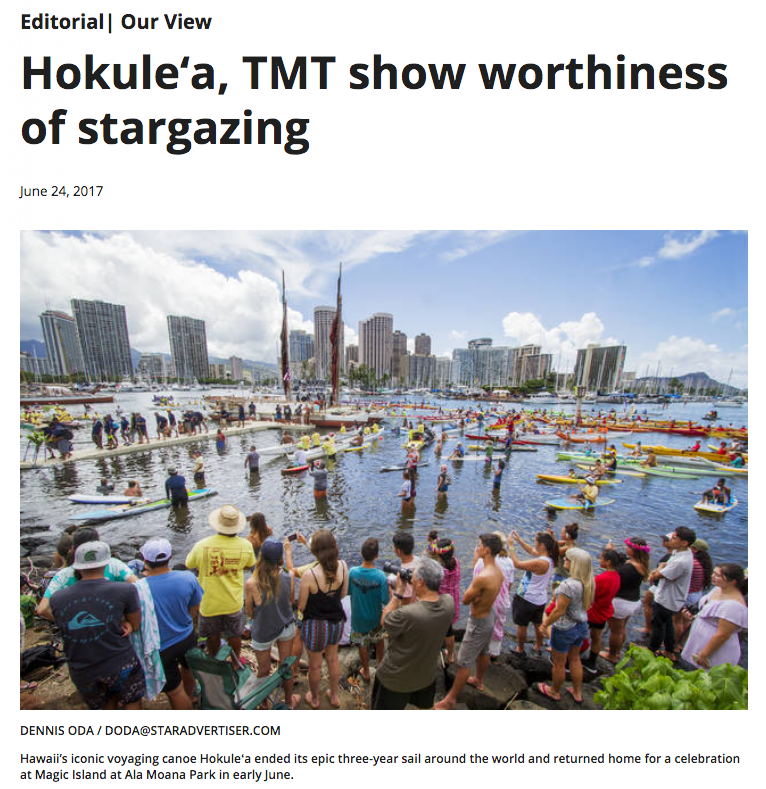

A week ago today, the voyaging canoe Hokule'a made its triumphant return to Hawaii after its three-year Malama Honua journey around the world. The venture was truly worthy of celebration, validation that extraordinary feats are wholly achievable if one only dares imagine. Given Hokulea's success and steady eye on the future, then, it's jarring to contrast the outpouring of cultural pride over this stargazing navigational achievement, against staunch opposition to the proposed Thirty Meter Telescope atop Mauna Kea.
The TMT proposal is winding its way through complex regulatory processes that include legal hurdles. A contested-case hearing on Hawaii island has just ended, with hearings officer Riki May Amano now crafting a recommendation to the state Land Board over a conservation district use permit application for the telescope.
The virtues of this project are numerous, despite vocal opposition from some Native Hawaiians and others who consider Mauna Kea too sacred to site this telescope. TMT would be the largest among the 13 observatories currently atop Mauna Kea, but it, like the others, is subject to a management plan that has been refined for improved area stewardship. The $1.4 billion TMT would be the world's most powerful telescope, a magnificent stargazer atop one of the world's very best sites for celestial learning. It would enable scientists to see some 13 billion light years away, to look into the early years of the universe.
The value of Mauna Kea's telescopes was underscored Monday, with announced findings of possible Earth-like planets where liquid water could exist. Detected by the Kepler space telescope, it's now largely up to the Keck Observatory on Mauna Kea to conduct confirmation.
For local generations, the astronomy sector in Hawaii offers vast educational opportunities. It's an industry and future that promote skills, learning, expansion of horizons - all exciting prospects, not limiting ones.
As noted last fall by Richard Ha of the Native Hawaiian entity, PUEO (Perpetuating Unique Educational Opportunities): Hawaii island has the lowest median family income statewide, the highest rate of homelessness and the highest suicide rate. Education is seen as the great equalizer.
Toward that end, TMT's nonprofit has pledged $1 million annually over its 19-year sublease to boost science, technology, engineering and math (STEM) education for students on Hawaii island. It has kept that pledge for two years now, despite TMT's legal limbo.
That limbo includes the land board's decision on the Mauna Kea permit for TMT, as well as another legal obstacle challenging the University of Hawaii's sublease with TMT. The entanglements, involving Hawaii's Supreme Court, are delaying a worthwhile project, which Hawaii risks losing if construction cannot start by April.
In his November testimony at the contested case hearing, Hawaiian navigator and voyaging canoe captain Chad Kalepa Baybayan provided profound perspective.
"It is culturally consistent to advocate for Hawaiian participation in a field of science that continued to enable that tradition, and a field of work in which we ought to lead," he said. "I firmly believe that the highest level of desecration rests in actions that remove the opportunity and choices from the kind of future our youth can own."
Baybayan is former resident navigator for the Imiloa Astronomy Center, and yes, an employee of UH, which manages the Mauna Kea summit under a state Department of Land and Natural Resources lease. But notably, he also is "a descendant of some of the best naked-eye astronomers the world has ever known."
In rare splendor, Hokule'a's crews have marveled at the map of the heavens, deeply studied its cosmic array, and divined inspiration and guidance from the stars. These celestial mysteries speak to us, to Hokule'a's voyagers as they once did to the ancient Polynesian wayfinders. Likewise, they call to the astronomers atop Mauna Kea - rare among the world's best sites - and challenge them to explore our universe.
|